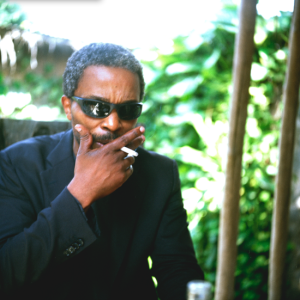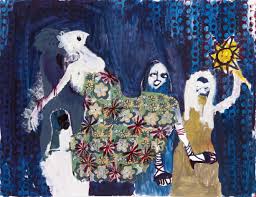
Simon Njami.
22-24 August 2014. Sandton Convention Centre.
Events in relation to the fair:
1. Simon Njami
…on approaching curating as a storyteller, and the Master Class at this year’s FNB Joburg Art Fair
JAF: As an author before becoming a curator, do you feel that your modes of thinking as a writer have influenced how you conceptualise exhibitions?
SN: Indeed. I consider myself as a writer above all. I see myself as a storyteller. People in Africa are always raving about constructing new narratives, writing another history and so on… I don’t care that much about stories written by others. I mind when those stories are supposed to describe me. I have decided to write my own stories, and to force people to enter them… or not. Which means that I have to think from another point in space and time, that is the present, my present.
JAF: Which contemporary African artists are you excited about?
SN: Those who are dealing with what Homi Bhabha, if I am not mistaken, called the glocal. I like it when an artist is rooted in one place, but nevertheless tells me a story about the world. Giving meaning to what we are going through now globally. I don’t care about the techniques they use (all are represented in my shows), but rather the pertinence of what they are expressing, technically, aesthetically and conceptually.
JAF: Based on your experience of judging the FNB Art Prize, what significant threads, if any, do you currently find running through contemporary art from South Africa?
SN: What I find nice is that, finally, more and more South Africans are embodying the world. They are moving away from little traumas and are getting more and more aware of the fact that they are not the centre of the world and that history does not start and end in South Africa. I guess it is due to the increasing circulation of works and people.
JAF: Tell us about the Master Class.
SN: I have always thought that what was missing the most throughout Africa are places of debate. Places of discussions, exchanges and thoughts. Outside of the usual circles that are, sometimes, doing a great job, an artist needs to be confronted with a brutal reality. He has to be encouraged in his quest of a language and of a personality of his own. That is what led to conceive those master classes, where mid-career practitioners and younger ones are locked in a place for a week, without their cameras, discussing images and the process of images making. Photography is more than taking a picture. Professionals who they would never have dreamt of meeting in such an intimate setting will assist them: curators, critics and photographers from around the globe. The other thing is that they have the opportunity to visit Africa and to discover other challenges. From inception, we’ve hosted these classes in five or six different countries. And it is always a true joy for us when, along the years, we see people who entered the master class quite unprepared, and subsequently make their way through the complexity of what it means to be an image producer from Africa.
Simon Njami is a writer, an art critic and an independent curator. He has curated many exhibitions among which: Africa Remix, the first African Pavilion at the Venice Biennale (2007), with Angolese artist Fernando Alvim. His latest shows are A Collective Diary (Tel-Aviv, 2010), A solo show of Cameroonian artist Bili Bidjocka (Paris, 2010) A Useful dream (Brussels 2010) and his latest touring show, The Divine Comedy, opened in March at the MMK in Frankfurt. Njami was the cofounder and is the chief editor of the Paris based magazine Revue. Njami has been the artistic director of the Bamako (Mali) photography Biennale for ten years. His latest book a biography of President Leopold Sedar Senghor was published in 2007 (Fayard, Paris). He is also one of the judges of the 2014 FNB Art Prize.
2. FNB Art Prize 2014 – Portia Zvavahera

JAF: Why did you become an artist?
PZ: I had a passion for drawing when I was in school. I loved art more than any other subject. I didn’t know that I could do it as a career. When I discovered the school of art, I knew it was what I wanted to do.
JAF: Who have you been most inspired by in your career?
PZ: I’m most inspired by Jean- Michel Basquiat and Gustav Klimt. I loved the pattern and use of organic circles that Klimpt used.
JAF: What is the significance of your dreams in the work you make?
PZ: I’m mostly inspired by my dreams. When I have a dream, a nightmare or something, I usually forget it so I have to write it down and the dream itself becomes my personal diary. Documenting them becomes a history making process. It is also sort of a healing process, when I translate what I’ve written on paper with paint on canvas.
JAF: How do you hope your work will speak to your audience?
PZ: It is a platform for people to engage with the healing process. It is always interesting to see how people relate on a personal level to the work. One person after seeing one of my paintings (Ndakavhumbamira, 2014 see: http://www.stevenson.info/exhibitions/zvavahera/ndakavhumbamira.html) spoke of how the painting moved him. He was away from his family and the painting made him feel closer, like he was holding them.
JAF: What does the medium of painting add to your process?
PZ: I don’t really like writing about my dreams. I prefer to transfer the image from my dreams into a painting. I see colour everywhere, I love colour and paint more than other media. I feel colour translates best through paint.
JAF: What’s next for you?
PZ: I’m constantly searching. I’ll never stop searching for new ideas. What comes next is a product of that ongoing search.
3. Gabi Ngcobo
…gives some insights on the inner workings behind Create, Curate, Collect, a Special Project at the 2014 FNB JoburgArtFair
JAF: For the 2014 FNB Joburg Art Fair, you are involved in more than one role- both as a judge for the FNB Art Prize and as an invited curator on a Special Project. What has your experience been of judging the prize?
GN: Judging this particular prize was a process previously unknown to me, (not that it was top secret), it was revealed to me at a time when I was thinking about the nature of art prizes in general, having served as judge in some and a selector in others. The jury process was both easy and difficult – easy mostly because of the artists presented by galleries and difficult because of the various strategies the galleries employ to package the artists’ work. It sparked for me a set of new questions and differently desired realities of the art market.
JAF: What do you hope Create, Curate, Collect will bring to the Fair’s audience? Why have you selected both Megan Mace and Dawood Petersen in particular?
GN: I’m hoping that Create, Curate, Collect will extend the dialogue initiated by Dawood, Megan and myself and also invite audiences to reconsider their role in the Art Fair environment. Working with Megan and Dawood was not a selection per se; it was never a matter of selecting any artist or any collector. I wanted to work with Megan because her work interrogates various aspects of the art system: the art school, residency programmes, exhibition opening rituals, etc. Dawood because of the unconventional approach he has to collecting art. Without Dawood and Megan, this project would not exist. For me it is about being in the right place at the right time.
JAF: How was Create, Curate, Collect conceived?
GN: The project came to be because Megan and Dawood have worked together. Megan’s final year project I Went to Art School (2013) took place inside Dawood’s house, amidst his art and book collections. I came to witness it as both a participant in the project and as part of the year-end marking sessions which took a number of the Wits School of Arts lecturers to Dawood’s house to mark Megan’s project. I have worked with Megan both as her tutor at the Wits School of Arts and in my capacity as an independent curator. I’m interested in her ideas and her work, most of which is uncollectable or demand that we re-think collectability of things, experiences that are framed within art in particular.
JAF: How has it progressed?
GN: The project is taking its own shape. It was conceptualized as a set of instructions we give each other based on how the project has framed us (creator, curator, collector), frameworks each of us reject in one way or the other. Megan’s work often embodies performative curatorial sensibilities, her practice questions and challenges institutions of art making and consumption. Dawood refers to his collection as an ‘assemblage’, it will seem all other artists’ works in his collection are also there to keep his own artwork company and are arranged as objects that document an imagined world. In 2008 Dawood’s work was selected and exhibited as part of the Spier Contemporary Award. The work, a painting, proposes other strategies of winning; ones that traverse established ways of playing or participating. The work takes its space in the balcony of his apartment. I, on the other hand, am always fighting with all these terms and only use them to get through small talk or when I’m too lazy to explain further. So, it is not a matter of progress but rather of developing alternative strategies of being (in the art world).
JAF: Your previous projects often follow the subjectiveness of memory. What drives this fascination?
GN: Unanswered questions, un-answerable questions and possibilities for escape into the fictional and speculative – when reality is just too much.
JAF: What is the next big project for you?
GN: I will start an NGO.
Gabi Ngcobo is an independent curator and the co-founder of the Johannesburg based independent collective platform, the Center for Historical Reenactments (CHR). She holds a Masters degree from the Center for Curatorial Studies, Bard College (New York) and is a faculty member at the Wits School of Arts, University of Witwatersrand in Johannesburg. Recently Ngcobo curated “DON’T/PANIC” an exhibition which took place at the Durban Art Gallery and coincided with COP17, the United Nations conference on Climate Change. Commissioned by the Goethe Institut, the exhibition featured 27 artists and contributors. Other curatorial projects include collaborative and individual projects: Second to None at the South African National Gallery, Olvida quen soy/ Erase me from who I am at CAAM, Canary Islands, 2006, CAPE 07 in different venues in Cape Town, 2007,Titled/Untitled, a curatorial collaboration with Gugulective collective and Scratching the Surface Vol.1 at the AVA Gallery, Cape Town. In 2010 Ngcobo co-curated Rope-a-dope: to win a losing war at Cabinet, New York, Second Coming, a curatorial collaboration at the Center for Curatorial Studies, Bard College and Just How Cold Was It?’ At ‘6-8 Months’ project space, New York City. At CHR she curated PASS-AGES: references & footnotesat the old Pass Office and an ongoing project titled Xenoglossia, a research project. Ngcobo has given talks and lectures at various places, including “The Names We Give” at the Michaelis School of Arts, “Other Possible Worlds” at NGBK, Berlin, “The Now Museum” at the New Museum, New York, “Condition Report” at Raw Material, Dakar, “What Does an Art Institution do: How Size Matters?” at Tensta Kosnthall, Stockholm and “The Radius of Art” at the Heinrich Boell Foundation, Berlin.



